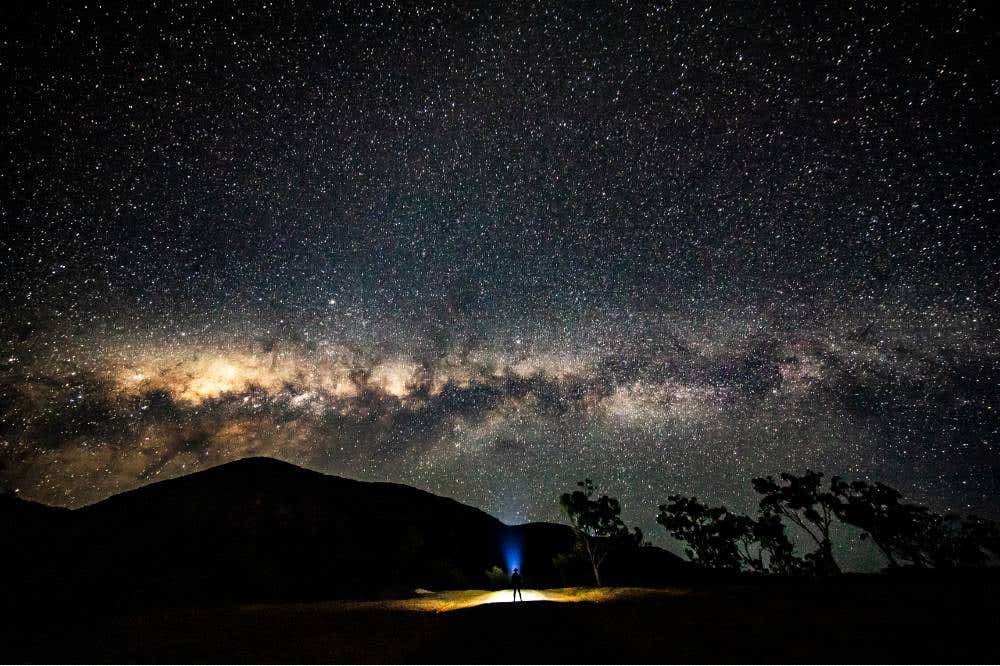How To Choose the Best Binoculars for Stargazing
Nestled in Far North Queensland, Mt Mulligan Lodge has a breathtaking view of the black velvet night sky — and it’s one of the best places for stargazing in the country as it’s free from pollution. If you’re planning a stay at the secluded luxury outback lodge and want to spend some time exploring the galaxy above, we highly recommend bringing a pair of binoculars to discover the varying constellations, stars and planets of the southern night sky.
Just like cameras, binoculars have specific specs and features that set each pair apart. When stargazing is on the agenda, here’s what you need to know about choosing the best astro binoculars.
How do binoculars work?
If you’re thinking of buying stargazing binoculars for your trip, there are a few key terms that will help you wrap your head around how binoculars work.
All binoculars are identified by two numbers with an “x” in between, such as 10x25 or 8x40. The first number refers to the magnification the binoculars offer. So, if you’re using a pair of 8x40 binoculars, objects will appear 8 times closer than they do with the naked eye.
The second number is the size of the objective (or front) lens of the binoculars in millimetres. The larger the number, the brighter, bigger and clearer the image you see will be. Binoculars with large objective lenses work well in low light, so they’re the best binoculars for stargazing and other after-dark activities.


These numbers aside, binoculars are also classified by the type of prism used in their design. Porro prism binoculars are the most common, and their Z-shape design is easy to produce. They offer a clear and detailed image, but they can be quite heavy and bulky. On the other hand, roof prism binoculars have a “straight through” design. They’re more compact and travel-friendly than porro prism pairs, and offer the same kind of clarity. The catch? These binoculars are tricker to make, so they’re expensive.
What to look for in astronomy binoculars
When you’re shopping for stargazing binoculars, there are three main specs to consider.


Lens size. Since stargazing is a nighttime activity, you’ll need a pair of binoculars that let in plenty of light — so you want to choose binoculars with larger objective lenses. While you could work with 40mm or similarly sized lenses, we’d suggest opting for a pair with 50mm lenses or larger to get the clearest, most detailed images. These are the most powerful binoculars for astronomy, so you’ll give yourself a jaw-dropping viewing experience!
Magnification. The best magnification choice comes down to what you want to see in the sky. If you’d like a big-picture view that allows you to peer at large portions of the sky, a small magnification like 8x might be sufficient. But if you want to get up close to stars and comets that are literally light years away, a greater magnification between 10x and 20x is a better pick. For that reason, you’ll find the most popular binoculars to see stars are these sizes: 10x50, 12x50, 15x50 and even 20x60.
Field of view (FOV). This is the width of the scenery you can see through your binoculars. It’s measured in degrees, and the larger the number, the wider the FOV. For stargazing, go for binoculars with a wide-angle FOV to complement your viewing.
Other useful features. To make your stargazing session more comfortable, consider buying a pair of binoculars with a tripod mount. You could also choose binoculars that can be adjusted to sit on the bridge of your nose, and if you wear glasses, go for a pair with longer “eye relief.” This refers to the distance between the eyepiece lens and the eyepoint (the surface you press your eye against), and a longer eye relief means you won’t be restricted to a smaller field of view.
The best binoculars for stargazing
With all those specs and features in mind, these are our top picks:
- For the beginner: Bushnell 10x50 Powerview Binoculars
- For the seasoned stargazer: Nikon 10-22x50 Aculon A211 Zoom Binoculars
- For the professional: Pentax SP 20x60 WP Binoculars


5 stargazing tips for beginners
Now that you know what you need in a pair of binoculars for stargazing, it’s time to set yourself up for a night of admiring the sky! Here’s how to make the most of your stargazing binoculars and have an unforgettable experience.


1. Find a good vantage point. Before nightfall, survey your surroundings and settle on the best place to see stars. Ideally, you want a clear view of the sky that’s free from buildings, trees, power lines and other obstructions. This will be easier to achieve if you can get up high, so chat to the staff at Mt Mulligan Lodge to see if they can help you find a stargazing spot.
2. Choose a clear, calm night. Unfortunately, stormy and overcast weather isn’t conducive to a night of stargazing. You won’t be able to see the stars clearly through the cloud cover, so you may want to postpone your session until you're in the best place to see the Milky Way.
3. Download a stargazing app. Planning your trip around stargazing? A stargazing app will help you track important lunar events that could make your stay at the lodge more memorable, such as moon phases.
4. Set simple goals. Like photography, stargazing takes practice — and we all need to start somewhere! To familiarise yourself with your binoculars, focus on finding easy objects in the sky, such as the moon. When you’re ready, you can move on to trying to find constellations and smaller landmarks.
5. Clean your binoculars regularly. Pack a cleaning kit so you can safely wipe away any dirt and dust from your binoculars and keep those precious lenses in tip-top condition. The Hahnel 6-in-1 Travel Cleaning Kit has microfibre cloths and screen wipes, and comes in a waterproof bag that you can slip into your luggage.
All images used copyright @seanscottphotography
Browse our range of astronomy binoculars
Whether you’re travelling to the outback or want to appreciate the night sky from home, a good pair of astronomy binoculars will help you to spot stars and planets.
Shop our binoculars for stargazing online, or drop by your local Ted’s Cameras store and our team will be happy to help you narrow down your options.
Next Post
How To Photograph Architecture
Previous Post
How To Clean and Care for Your Camera







